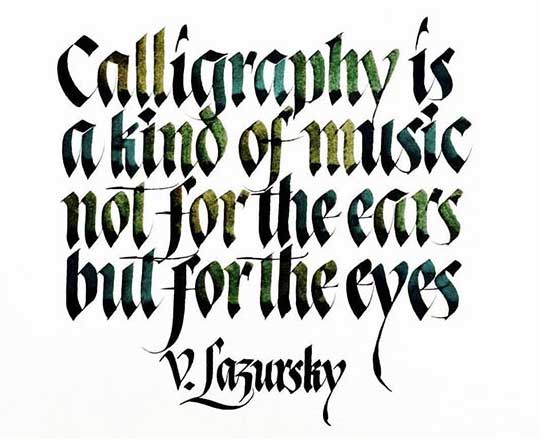A pen is more than just a tool, it is a vehicle of enlightenment. This is not a smart branding of a pen manufacturer, it is ancient wisdom common for many cultures. Just like a sword is a continuation of the warrior’s will, a pen is a continuation of the philosopher’s soul. Can this idea be useful beyond poetry? Let us consider this together.
Calligraphy pens
The idea of the soul of a pen starts with calligraphy, especially Muslim and Chinese (Japanese) calligraphy.

Muslims could not draw real objects, so they draw beautiful objects via beautifully written texts. Kilk’s site states: Every pen is a poet in its own realm. Here is an example of Turkish calligraphy:

While the muslim caligraphers looked for calligraphy as a way to express themselves, Chinese characters are simply very complex. Thus until the 20th century, Chinese (or Japanese) needed to learn calligraphy for years simply to write properly. And then they went beyond proper writing into the domain of enlightenment through writing.

The enlightened calligraphy transcends the readable fonts, into the domain of motion and music. It looks like a brush is dancing on the paper, as the master’s eyes are fully focused or entirely blank.
Eastern calligraphy with a quill or a brush can be exciting, but it can be also too intense and extreme for most of us. How did Europeans and Americans use their pens?
Writers and their pens
For some authors of 100 years ago, their fountain pen was their main working tool. The typewriters used to be significantly slower, and not eraser-friendly. It was easier just to hire a qualified typist to do both typing and line editing, that type yourself. So the masterpieces we know were written with luxury fountain pens.
Some of the pen companies sponsored famous authors and made signature models, very much like guitar companies today. Montblanc Sir Winston Churchill 53 (22K $) was probably the priciest. Ernest Hemingway had a whole Montegrappa collection. Others were moderately priced for a workhorse fountain pen. Stephen King – Waterman Hemisphere (99$), Mark Twain – Conklin Crescent Filler (99$), Arthur Conan Doyle – Parker Duofold (99$), Albert Einstein – Pelikan 100 N (200$).
Today’s writer and editors use very inexpensive pens if any: Pilot G-2 Gelm Uni-ball Jetstream, and even dirty cheap Bic Crystal. Meh… It feels like the modern authors lack sole, not just in the way they write but also in the tools they use…
Holy grail pen
Pen enthusiasts are just the opposite. These people do not necessarily write for a living. Some are doctors or lawyers. Others are old-school enterprenuers. And then there are those who simply enjoy art, history, mindfulness, or luxury and the way they meet in one product.
The best pens are so-called holy grail pens. These pens are usually hand-produced, expensive, rare, and special both in the way they look and in the way they write.
Some of the typical holy grail pens range between 600$ and 2000$. Any Nakaya pen is a holy grail, but Dorsal Fin 2 is more than that. Aurora is a very special Italian manufacturer with pencil-like tactile feedback in their nibs. Delta Dolce Vita or Parker Big Red or Black-Green Pelican m1000 are a part of modern history and must-have for many. Visconti Homo Sapience with their heavy “lava” material is highly collectible. And then there are custom pen companies and yet more designs and options.
Each of the holy-grail pens is full of soul, waiting for the right owner. I have a couple of pens with soul, like Pilot 912 FA and Faber-Castel Guillioshe. At around 170$ they are definitely luxury, but not the “holy grail” level of luxury.
I promise you, none of the holy grail pens I know were actually used for creating a masterpiece. Even people who love their pens usually rely on unpretentious models.
Workhorse pen
Some pens do not quite cut into the elite “holy grail” club. They are a pure joy to use, but not truly a luxury item. They are just too robust to be luxury.
Consider for example Lamy pens. Lamy Safari is a great pen for a student or a doctor, a lawyer or an engineer. Maybe not for a wealthy industrialist or art gallery owner, but who cares. If you want half-a-step up Lamy 2000 is very stylish. Lamy pens have a huge ink reservoir, a vast and not very expensive variety of nibs, and german production quality. Depending on the model, it can cost you between 100$ and 300$, but then the pen is ergonomic, well balanced, and virtually indestructible. And changing the nibs (9$ per steel nib) you can use any style of writing and calligraphy.
This is an example of a model work pen. You can use it to write in lectures, to sign your deals or prescriptions, to annotate and comment the documents you read. If you want you can get a matching ballpoint pen or a pencil, or a fountain pen with a wide calligraphy nib for highlighting. Everything you need in matching colors.
If you think Lamy is too slim and tall, you can try Kaweco sport. And if you need a fancy workhorse, Montblan 149 can be considered. For all-metal design lovers, Loclen is a viable option. And of course, Pilot or Parker are great brands with a wide selection of excellent items to choose from. Way beyond the popular Parker Jotter or Pilot G2…
Workhorse pen has a soul, but it also has tons of stamina. You should not be afraid to drop it or replace nibs, or even have it clogged with a challenging ink. And if you happened to lose one, you can easily purchase another.
How did we become soleless?
With so many cool options, why so many of us use dirty cheap Bic Cristal? I can definitely understand the clicky charm of Parker Jotter or the ergonomic joy of Pilot Dr Grip. But a person who uses Bic Crystal challenges the entire concept of joyful writing.
I asked some of my friends. The aggregated answer I got was a kind of zen. “Writing is a function, not a tool. The tool is disposable and replaceable. The text itself can find its way into the garbage can. But the ideas and understandings are transferred into digital media and stay with us forever.”.
The rise of knowledge workers, the combination of computers and dirty cheap pens transcended the tool into the dimension of knowledge.
Rediscovering our soul
There is a slowly rising new movement, looking for grounding in everyday objects. Our lives are simply too abstract. It feels as we do not really live, but exist in some mixed reality metaverse. There are very few things that firmly ground us in this world rather than the various worlds we create. Sports, food, and mindfulness are some of those.
When we practice mindfulness, it can go well beyond meditative practice. It can deal with noticing the way we do simple things. The way we walk, the way we breath and definitely the way we write.
We kind of rediscover calligraphy from a very different point. Not because we have to or because it is a powerful tool, but because it allows us to feel and see some deep connection with our inner spirit, our body, and our history. And we want beautiful tools with wonderful feedback for this journey.
Why use fountain pens for mindful writing?
I honestly do not know if fountain pens are the best tools for mindful writing.
Asians might prefer beautiful brushes. Some modern brushes are built almost like fountain pens, only instead of a firm nib, there is a soft brush.
Another question is dipping vs automated flow. Caligraphy nibs and brushes can be dipped in the paint. The results are often very dramatic with much better control over the details. You can have any form of grip and you are not expected to put your dip tools in your pocket. And the colors can be of any viscosity.
The automatic flow of the ink in fountain pens and pen-like brushes ensures that we do not need to dip it. The colors and flow are more uniform. We can put the pens in our pocket and doodle anywhere, including in nature. And the result is not messy. The work itself is much faster and less likely to stain the artist.
Unlike pencils and ball pens, when we write with a fountain pen or a brush, the colors are very vibrant. The ink dries in front of our eyes and we can add shading with a water-dipped brush. The control over the line width and shading depth may add some level of sophistication. We are very much aware of the writing process itself, not just the message. And we are less likely to put the result in the garbage bin. A luxury pen emphasizes the process.
Contextual memory
Our memory and our creativity work in a context. Switching the writing environment we switch the context and come up with different ideas. Using consistent tools that “capture our sole” we generate a consistent result.
I enjoy many writing tools and G2-type refills for Parker, but when I need to solve a math challenge I take my Parker Jotter pen with original Parker ballpoint refill. It is not silky, vibrant, or the most comfortable refill, but it activates the memory captured by thousands of math challenges I already solved with that particular kind of pen. The tactile feedback makes me wiser, by connecting me with the right kind of memories. My sole as a mathematician is captured by an imperfect pen.
When I switch to one of my fancy pens, my mind goes blank. I am like a child. I can think our of the box and generate all sorts of ideas, admire the writing process itself, or doodle. The pen does not capture my sole, yet. If I use it for a specific kind of writing, the context will be created. Then simply taking that pen, I will become a different person. That’s a neat trick, isn’t it! You cannot quite do it on a computer.
A pen is more than a writing utensil, it is a vehicle for our thoughts. Taking another vehicle changes the entire experience.

